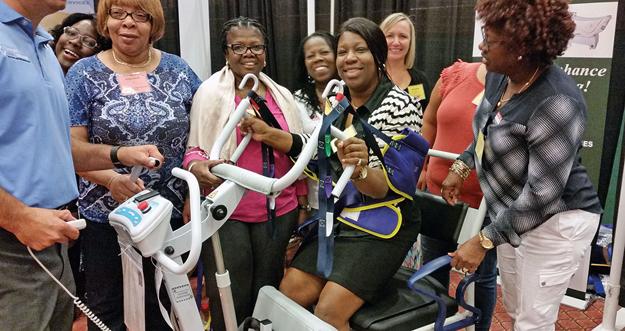Zero Lift: Safer for patients; safer for us

Ready. Set. Safe Patient Handling training. It’s safer for patients and safer for us.
The New York State Safe Patient Handling Law (SPH), which was passed in 2014, required healthcare facilities to have labor-management SPH committees in place by January 1, 2016, and to have their SPH policies in place by January 1, 2017. Record numbers of healthcare professionals came to Buffalo this September for the Safe Patient Handling Conference, sponsored by the Zero Lift Task Force, of which NYSNA is a member, and the New York State Department of Labor. NYSNA nurses joined healthcare professionals from across New York State in reviewing state-of-the-art technologies and best practices for worker safety in their facilities. All hospitals and nursing homes must be in compliance with the law by the January deadline.
The SPH law was passed to address extraordinarily high rates of musculoskeletal injuries suffered by nurses and other healthcare workers. Sharon Greenaway, an RN in the NYC public hospital system’s (NYC H+H) North Central Bronx Hospital for 30-plus years, has seen many healthcare professionals injured because of heavy lifting on the job: “Sometimes, particularly in emergencies, nurses pay a terrible price,’ said Ms. Greenaway. “In fact, I met someone at the conference who got involved in SPH only after suffering an injury. That’s not the right approach. Get trained in SPH and avoid learning the hard way.”
Reducing injuries
SPH policies and technologies are designed to reduce dramatically the strain of manual lifting and decrease the number of injuries to healthcare workers, improve outcomes for patients and save healthcare facilities money. The Zero-Lift Task Force, comprised of NYSNA and other healthcare unions, patient advocacy groups, and the New York Department of Labor, sponsors the annual conference to help practitioners stay current on best SPH practices and technologies and implement effective worker safety.
At the conference, healthcare professionals were trained to conduct environmental and patient mobility assessments; use mechanical aids for moving, repositioning, and lifting patients; and prevent accidents. Zero Lift also provided hands on demonstrations in cutting edge SPH technologies. Ms. Greenaway was most impressed with the sit to stand equipment. “Getting patients up and mobile is a central task in so many departments, and it is something that most of us do several times a day,” she said.
Leadership is key
North Central Bronx is currently conducting its unit-by-unit SPH needs assessment. Zero Lift provided a wealth of new information and ideas for her SPH committee, Ms. Greenaway said. “SPH is about technique as well as equipment.” She added, “We used to rely on body mechanics to try to avoid injury, but we know that’s not enough. We have to ensure that everyone is trained in new techniques and uses the equipment once it’s in place.”
While conducting an assessment of SPH equipment at NYC H+H's Bellevue Hospital Center it was found that there was some equipment in place that staff had not been adequately trained to use. To remedy the situation, Bellevue’s nurse educators implemented staff training to ensure their healthcare professionals learned how to properly use the existing SPH equipment.
For Sarah Chmura, RN, Erie County Medical Center (ECMC) and NYSNA Board Member for the Western Region, leadership is the key take-away from the conference. “Any time you ask people to change the way they do things, you meet some resistance. SPH must be addressed in a way that generates buy-in from the nurses and other direct caregivers,” she said.
In September, ECMC was about halfway through the process of developing its SPH policy. It will be an ongoing effort, Ms. Chmura said. “Putting an SPH policy in place that works will take a lot of trial and error in each department and will vary with patient needs.” NYSNA members and staff are working closely with covered facilities to ensure they are able to implement successful safe patient handling programs.
This year’s Safe Patient Handling Conference was the best attended of any of the seven prior conferences. The five hundred healthcare professionals from 184 healthcare facilities who were on hand — including more nurses, occupational therapists, technicians, educators, and others — left better education in SPH technology. They are now well-positioned to help their hospitals , clinics, and nursing homes make the January transition to better workplace safety practices.